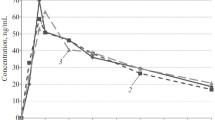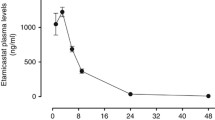Summary
The pharmacokinetics of propranolol in 16 hypertensive patients was compared after the first oral dose of 80 mg and during chronic treatment with 80 mg bd. The degree of beta-adrenergic blockade was estimated by the reduction in maximal exercise heart rate. No significant change in plasma half-life occurred and there was no correlation between the mean steady-state propranolol concentration and beta-adrenergic blockade or antihypertensive effect. A linear relationship was observed between the decrease in blood pressure and the reduction in heart rate during maximal exercise. Therefore, the antihypertensive effect of propranolol can be explained by its peripheral beta-adrenergic blocking properties.
Similar content being viewed by others
References
Bruce RA, Blackman JR, Jones JW, Strait G (1963) Exercising testing in adult normal subjects and cardiac patients. Pediatrics 32: Suppl, 742–756
Chidsey CA, Morselli P, Bianchetti G, Morganti A, Leonetti G, Zanchetti A (1975) Studies of the absorption and removal of propranolol in hypertensive patients during therapy. Circulation 52: 313–318
Coltart DJ, Shand DG (1970) Plasma propranolol levels in the quantitative assessment of beta-adrenergic blockade in man. Br Med J 3: 731–734
Davidson C, Thadani U, Singleton W, Taylor SH (1976) Comparison of antihypertensive activity of beta-blocking drugs during chronic treatment. Br Med J 2: 7–9
Evans GH, Shand DG (1973) Disposition of propranolol. V. Drug accumulation and steady-state concentrations during chronic oral administration in man. Clin Pharmacol Ther 14: 487–493
Lehtonen A, Kanto J, Kleimola T (1977) Plasma concentrations of propranolol in patients with essential hypertension. Eur J Clin Pharmacol 11: 155–157
McDevitt DG, Frisk-Holmberg M, Hollifield JW, Shand DG (1976) Plasma binding and the affinity of propranolol for a beta-receptor in man. Clin Pharmacol Ther 20: 152–157
Offerhaus L, Van der Vecht JR (1976) Improved fluorimetric assay of plasma propranolol. Br J Clin Pharmacol 3: 1061–1062
Pine M, Farrot L, Smith S, McDonnald K, Chidsey CA (1975) Correlation of plasma propranolol concentration with therapeutic response in patients with angina pectoris. Circulation 52: 886–893
Rawlins MD, Collste P, Frisk-Holmberg M, Lind M, Östman J, Sjögvist F (1974) Steady-state plasma concentrations of alprenolol in man. Eur J Clin Pharmacol 7: 353–356
Shand DG (1974) Individualization of propranolol therapy. Med Clin North Am 58: 1063–1069
Shand DG, Nuckolls EM, Oates JA (1970) Plasma propranolol levels in adults. Clin Pharmacol Ther 11: 112–120
Author information
Authors and Affiliations
Rights and permissions
About this article
Cite this article
Krediet, R.T., Dunning, A.J. & Offerhaus, L. Relationship of propranolol pharmacokinetics to antihypertensive effect and beta-adrenergic blockade in the treatment of hypertension. Eur J Clin Pharmacol 18, 391–394 (1980). https://doi.org/10.1007/BF00636790
Received:
Revised:
Accepted:
Issue Date:
DOI: https://doi.org/10.1007/BF00636790




